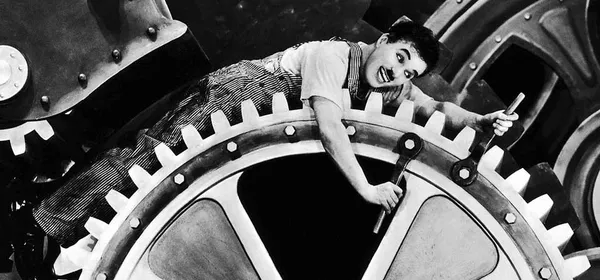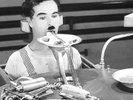Eye For Film >> Movies >> Modern Times (1936) Film Review
Modern Times
Reviewed by: James Benefield

"We ain’t burglars, we’re hungry." Charlie Chaplin is at his most socially aware, philanthropic and romantic with the 1936 Depression-era commentary of Modern Times. Like most of his feature films, it’s a piece where romance and social commentary battle it out for the most screen time. However, it’s a turning point for Chaplin; this was both the last time he used his famous creation, the little tramp, in a film, and the last of his silent films.
The little tramp (or, as he is credited, ‘the factory worker’) finds himself working in a nameless factory, in a nameless place. After being put under an inordinate amount of pressure on the factory floor, he suffers a nervous breakdown. When he recovers, he gets himself involved, partly by accident, in a communist rally against the factory’s working conditions, and ends up in prison. In the back of the police van he meets a young homeless girl (Paulette Goddard, who was later to become Chaplin’s wife) referred to as ‘The Gamine’. He falls in love with her, and together, they set about surviving prison, and on their release, battling it through the harsh industrial world grinding on around them.

Beginning with some striking images - a gigantic ticking clock, followed by an image of a herd of sheep which dissolves into a rabble of factory workers entering their work place at the start of the day - it’s clear what Chaplin’s attitude is to his modern times. These opening minutes of the film, leading up to the central character’s false imprisonment for leading a rally, are probably its most successful. Chaplin’s intermingling of the comedy and horror of industry and its effects on its workforce are grimly funny.
You can see why the US's House Un-American Activity Committee thought Chaplin to be harbouring communist sentiments, with this film’s release. The famous sequence where Chaplin gets sucked into one of the factory’s big machines and finds himself drawn into a machine-driven ballet is incredibly rich, intelligent and inventive. Despite the fact he is being crushed alive, he is serene. It’s preferable to the paradoxically stressful and monotonous production line work he was doing mere moments before. The film's other famous scene, where Chaplin is a guinea pig for a new machine that feeds workers fast, in order to eliminate the need for lunch breaks, is equally darkly humorous.
The film is mostly silent, and the limited dialogue is used with great success. The factory owner speaks, where the workforce, including the central character, remain silent. We are talked through the machine which is feeding Chaplin by a disembodied voice. Yet Chaplin still not does not speak. He only breaks his silence at the end of the film to please other people. He is involved in a performance to a volatile crowd, he speaks an improvised, mostly nonsense, form of Italian. The crowd, somewhat tellingly, love it.
Unfortunately, the film does peter off a little when a romantic interest is introduced. Although still rich with charm and perfectly executed slapstick, the film becomes a tad unfocused. Chaplin fails to make a strong enough connection between the plight of his new beau, and the little tramp’s continuing work-related exploits. The couple’s exploits in their falling down house pale somewhat in comparison to the grim comedy of poverty in his 1927 movie, The Gold Rush. The romance between the pair is also not especially developed or interesting, especially in comparison to other similar pairings in Chaplin films.
The film gains back momentum with its climax. The little tramp’s employment as a waiter has to be one of his best moments. Behind the comedy of Chaplin trying to make his way through a crowded dance floor with a tray balanced precariously on his upended hand, is the message that in modern times, the affluent do not really pay much attention to the humble, little guy. His subsequent performance on the dance floor to the club’s volatile audience is both at once humiliating and inspiring.
Modern Times does suffer from coming off the back of Chaplin’s masterpiece City Lights, and also for its undeveloped romantic narrative, which never comes alive of its own accord, feeling more like a tonic to the dark, socially aware humour than a pleasure in its own right. However, it does contain some of the little tramp’s most iconic movie moments and is a virtuoso display of the great man’s comic timing, imagination and social conscience.
After this, Chaplin never made a silent movie again. In an interview in 1931 to Time Magazine, he justified his making of silent films, saying he believed that actions translate far better, and to far more people, than words could ever do. His movie career was far from over, however, and he was to go on to make his most profound social statement in his 1940 masterpiece The Great Dictator, focusing on the rise of Adolf Hitler.
Reviewed on: 15 Feb 2009


















